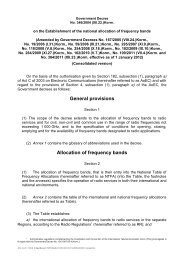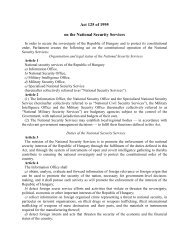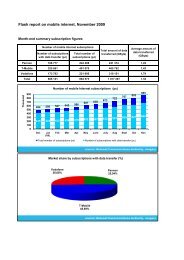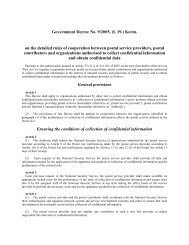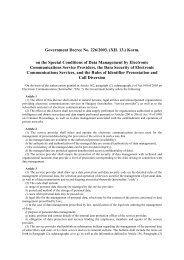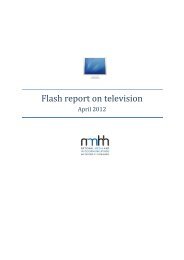The Hungarian Communications Market Developments and ...
The Hungarian Communications Market Developments and ...
The Hungarian Communications Market Developments and ...
You also want an ePaper? Increase the reach of your titles
YUMPU automatically turns print PDFs into web optimized ePapers that Google loves.
<strong>The</strong> <strong>Hungarian</strong> <strong>Communications</strong> <strong>Market</strong> <strong>Developments</strong> <strong>and</strong> Regulation between 2004 <strong>and</strong> 2008<br />
tions <strong>and</strong> the regulatory recommendations formulated on basis of<br />
the shortcomings detected into consideration.<br />
<strong>Market</strong> effects<br />
<strong>The</strong> main objective of the obligations imposed in the wholesale<br />
market of termination segments is the promotion of the output retail<br />
market competition, with ultimate results also for the consumers.<br />
<strong>The</strong> effects <strong>and</strong> success of regulation may be measured by analysing<br />
retail market processes, market shares, <strong>and</strong> prices.<br />
<strong>The</strong> revenue market share of the obliged Magyar Telekom in the<br />
retail market of leased lines with a b<strong>and</strong>width lower than 2 Mbit/s<br />
continuously decreased during the period. In the retail market with<br />
a b<strong>and</strong>width above 2 Mbit/s, the service provider had an even lower<br />
share (only below ten percent between 2005 <strong>and</strong> 2007).<br />
<strong>The</strong>re are many players in the market, with their share, from time<br />
to time, significantly fluctuating. <strong>The</strong> index indicating the extent of<br />
market concentration (Hirschman-Herfindahl Index featuring the<br />
sum-of-squares of the market share of players) shows a continuous<br />
decrease, i.e. increase in the intensity of competition <strong>and</strong> decrease<br />
in market concentration.<br />
Figure 4.24: HHI (Hirschman-Herfindahl Index) in the leased line<br />
market with a b<strong>and</strong>width lower than 2 Mbit/s<br />
%<br />
<strong>The</strong> analysis of retail prices seems to point towards competition in<br />
the retail leased line market. At the same time, the results show different<br />
pictures in the case of services with different b<strong>and</strong>widths. <strong>The</strong><br />
average prices weighted by the market share of the four largest service<br />
providers of the market (Magyar Telekom, Invitel, Pantel, GTS<br />
Datanet) 35 decreased in real terms with reference to all b<strong>and</strong>width<br />
categories from 2004 to 2006. However, this means constant prices<br />
“only” in nominal terms in the case of services with low b<strong>and</strong>widths<br />
(lower than 512 kbit/s). In the case of services with higher b<strong>and</strong>widths,<br />
there was a considerable decrease also in nominal terms,<br />
with the average price in 2006 being nearly forty percent lower than<br />
in 2004.<br />
Figure 4.25: Weighted average prices of leased lines<br />
%<br />
110<br />
100<br />
90<br />




